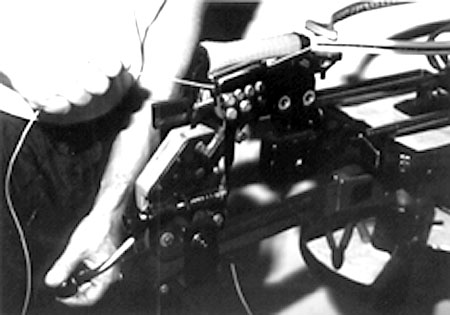|
|

Loss Of String Tension Giving You The Creeps?
By Steve Crandall
Vice President, Sales & Marketing
Ashaway Racket Strings
 Racquets and racquet string have to work together as a unit, and choosing the right string tension is one of the most important equipment decisions a racquetball player can make. It used to be a relatively easy one back in the "old days," before there were oversize racquets (way, way back, in the late '70s): all racquet heads were pretty much the same size and shape, and all racquets were strung between 25 and 30 lb. of tension. In other words, there was a spread of just 5 lb. or 20 percent, so you couldn't go too far wrong. Racquets and racquet string have to work together as a unit, and choosing the right string tension is one of the most important equipment decisions a racquetball player can make. It used to be a relatively easy one back in the "old days," before there were oversize racquets (way, way back, in the late '70s): all racquet heads were pretty much the same size and shape, and all racquets were strung between 25 and 30 lb. of tension. In other words, there was a spread of just 5 lb. or 20 percent, so you couldn't go too far wrong.
But technology doesn't stand still, and now we've got a wide range of racquet head sizes and shapes, action that varies from fairly whippy to ultra-stiff, and vast differences in stringing patterns. Recommended stringing tensions now range from 25 to 60 lb. The spread has grown to
35 lb., or 140 percent, which means there's a lot more room for error. Or to look at it in a more positive light: there's greater opportunity for the player to "tune" his racquet to suit his playing style by altering string tension over a wider range. If you don't like your racquet's performance, don't even think about buying a new one until you've experimented with changes in string selection and tension.
The basic equations are these:
Higher Tension = More Control
Lower Tension = More Power
Strings at low tension stretch more when they contact the ball, and then quickly snap back to their initial length. This "trampoline effect" (also known as resilience, or rebound) adds power to the shot: it's sort of like putting a spitball in a rubber band, pulling back, and then releasing it. If the racquet is strung at a higher tension, there's less stretch left in the string to provide trampoline effect. On the other hand, tighter strings remain flatter, so it's easier to control the direction of the ball and to impart spin to it. Bear in mind these limits, however: excessive string tension leads to frame or string breakage, and too-low tension means a total loss of both control and power.
Long strings stretch more than short ones under the same loads: in other words, they have more trampoline effect. This is the main reason why oversize racquets have more power than standard ones. Thus, we have the concept of relative, versus absolute, tension: string tension should be in proportion to head size. In general, oversize racquets call for tighter tension than
standard ones to achieve comparable playability. If you want extra control from an oversize, you'll have to string near the top of the recommended tension range -- possibly twice as tight as the maximum recommended tension on a standard frame.
A racquet loses roughly 10 percent of its tension the day after it's strung -- and that's if it's not used. The tension will drop further every time you play it. "Creep," or loss of tension, is due to stretch at the molecular level, and it's a fact of life: work with it, don't fight it. Think of stringing tension in terms of initial, or "reference" tension. Learn what reference tension works best for you over the useful life of the string, and go with that.
Checking tension on an already-strung racquet can be done with special equipment, but it's not a very fruitful exercise. When the string becomes too loose (if you haven't already broken it), that means the molecules have stretched out considerably, and tightening up the string in the racquet won't restore its original resiliency. So don't even bother trying to measure the tension of a strung racquet: just re-string it.
The construction of the string itself also affects string tension and performance. Kevlar(r) fiber, for example, is very stiff, and stretches much less than nylon under the same load, so you might want to string it at relatively low tension. Zyex(r) fibers resist creep better than almost any other material. How different materials are put together in the string also makes a big difference. We'll look into this subject more in future columns, so for now, just bear in mind that the proper tension for one string is not necessarily right for another.
It is always a good idea to discuss your needs with a certified racquet technician who specifically understands racquetball, but string tension is more like an exam in English than Math: there is no single right answer, and the final decision has to be the player's own, based upon his or her abilities, playing style, and preferences. If you're physically strong, you might want to add control to your game by stringing tight. Or you might want to make your shots even more powerful by stringing loose. Or you might choose something in between for a balance of control and power. Likewise with finesse players who are not so strong: you can select string tension to maximize your advantages, minimize your weaknesses, or strike a happy medium. By knowing how string tension affects play, you'll optimize your own performance and that of your racquet.
This article previously appeared in Racquetball Magazine.
|